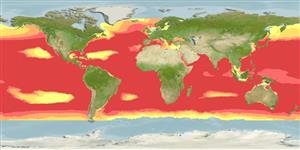Cephalopoda |
Oegopsida |
Pyroteuthidae
Environment: milieu / climate zone / Mức độ sâu / distribution range
Sinh thái học
Tầng nổi biển sâu; Mức độ sâu 50 - 800 m (Tài liệu tham khảo 97142). Subtropical; 68°N - 54°S, 180°W - 180°E (Tài liệu tham khảo 97142)
Atlantic Ocean, Indo-West Pacific and the Mediterranean Sea. Tropical to temperate.
Length at first maturity / Bộ gần gũi / Weight / Age
Chín muồi sinh dục: Lm ? range ? - ? cm Max length : 5.0 cm ML con đực/không giới tính; (Tài liệu tham khảo 97142)
Cosmopolitan in tropical, subtropical to temperate waters. In the South Pacific Ocean the species is common in the mixed waters of the subtropical frontal zone and the sub-Antarctic waters. Adults occupy the upper mesopelagic zone during the day and
then undergo diel vertical migration into epipelagic waters at night: off Bermuda, closing-net studies showed it occurs principally at 375 to 500 m during the day and
ascends to 75 to 175 m at night; in open net studies off the Canary Islands, found them at 400 to 800 m during the day and 50 to 100 m to 200 m at night. The species occurs in the eastern Mediterranean Sea/northern Aegean Sea in the mesobathyal basins (Ref. 97142).
Life cycle and mating behavior
Chín muồi sinh dục | Sự tái sinh sản | Đẻ trứng | Eggs | Sự sinh sản | Larvae
Members of the class Cephalopoda are gonochoric. Male and female adults usually die shortly after spawning and brooding, respectively. Mating behavior: Males perform various displays to attract potential females for copulation. During copulation, male grasp the female and inserts the hectocotylus into the female's mantle cavity where fertilization usually occurs. Life cycle: Embryos hatch into planktonic stage and live for some time before they grow larger and take up a benthic existence as adults.
Turgeon, D.D., J.F. Quinn Jr., A.E. Bogan, E.V. Coan, F.G. Hochberg, W.G. Lyons, P.M. Mikkelsen, R.J. Neves, C.F.E. Roper, G. Rosenberg, B. Roth, A. Scheltema, F.G. Thompson, M. Vecchione and J.D. Willams 1998 Common and scientific names of aquatic invertebrates from the United States and Canada: Mollusks, 2nd ed. American Fisheries Society (Special publication 26), Bethesda, Maryland. 526 p. (Tài liệu tham khảo 1667)
IUCN Red List Status
(Tài liệu tham khảo 130435: Version 2025-1)
CITES status (Tài liệu tham khảo 108899)
Not Evaluated
CMS (Tài liệu tham khảo 116361)
Not Evaluated
Threat to humans
Human uses
| FishSource |
Các công cụ
Thêm thông tin
Population dynamicsSự sinh trưởngMax. ages / sizesLength-weight rel.Length-length rel.Length-frequenciesMass conversionSự phong phú Life cycleSự tái sinh sảnChín muồi sinh dụcSự sinh sảnĐẻ trứngEggsEgg developmentLarvae PhysiologyThành phần ô-xy
Human RelatedStamps, coins, misc.
Các nguồn internet
Estimates based on models
Preferred temperature
(Ref.
115969): 6.5 - 20.4, mean 13.1 (based on 1426 cells).
Fishing Vulnerability
Low vulnerability (10 of 100).
